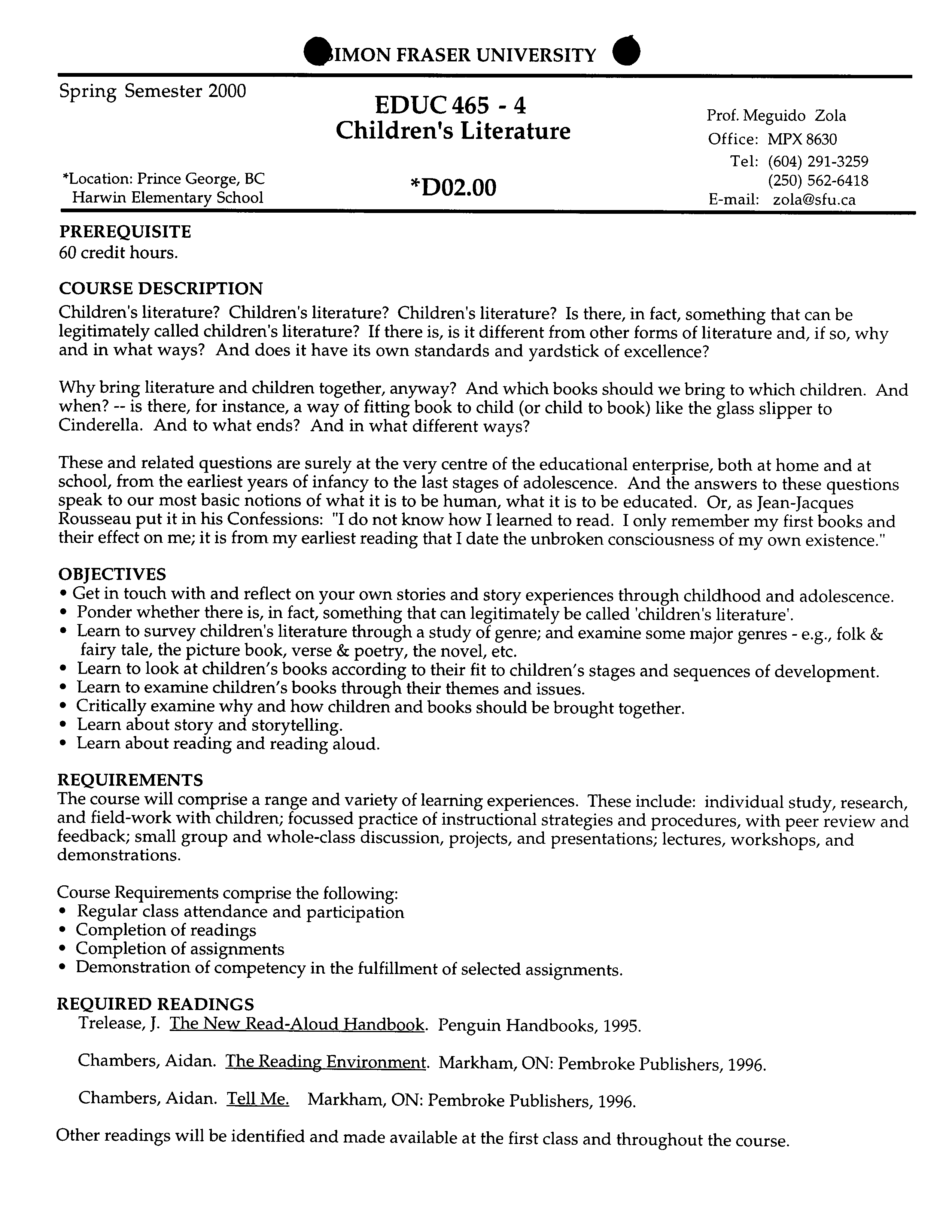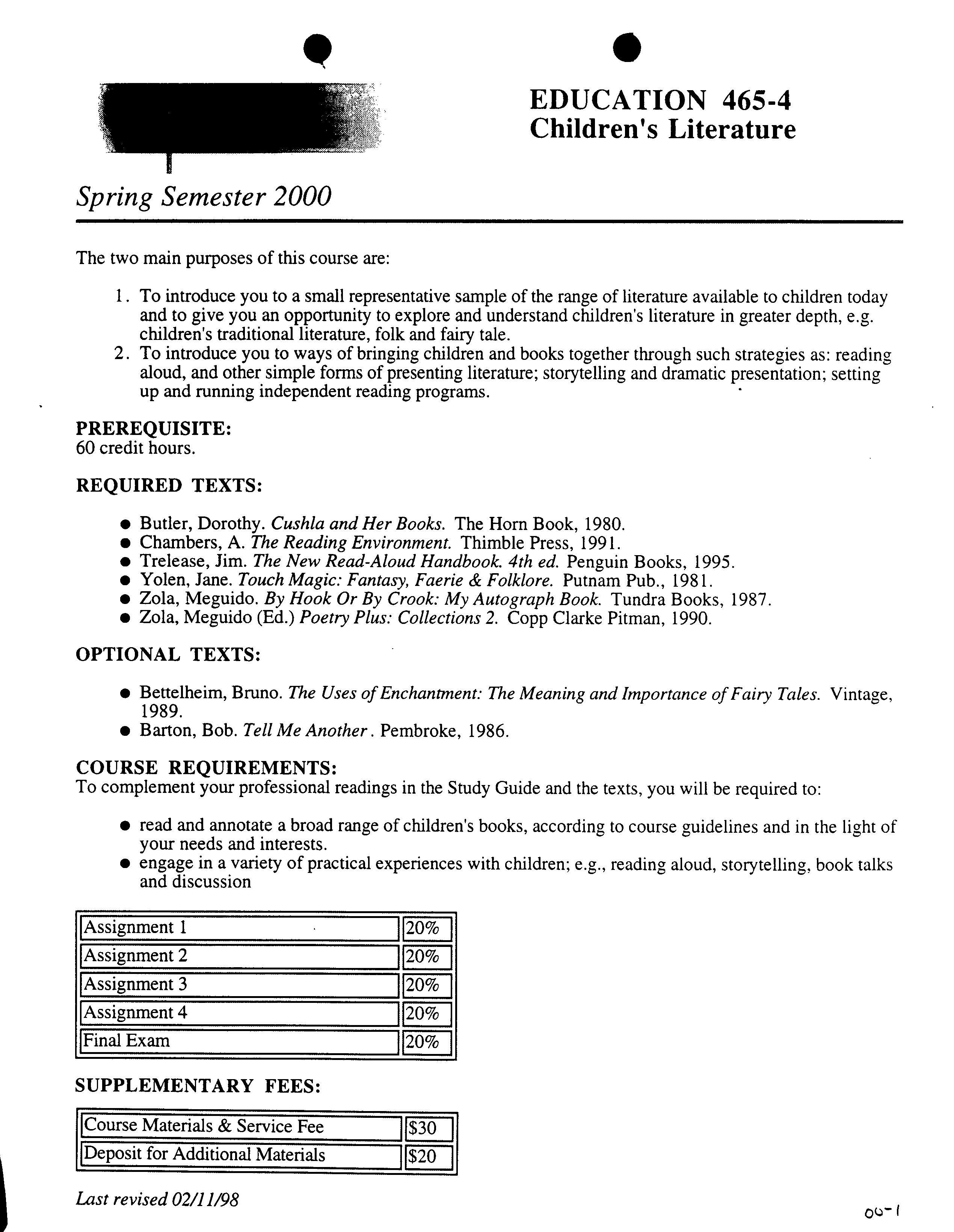SIMON FRASER UNIVERSITY
46
Spring Semester 2000 ?
EDUC 465 - 4
?
Prof. Meguido Zola
Children's Literature
?
Office: MPX
8630
Tel:
(604) 291-3259
*Location:
Harwin Elementary
Prince George,
School
BC
??
*D0200 ?
E-mail: zola@sfu.ca
(250) 562-6418
PREREQUISITE
60 credit hours.
COURSE DESCRIPTION
Children's literature? Children's literature? Children's literature? Is there, in fact, something that can be
legitimately called children's literature? If there is, is it different from other forms of literature and, if so, why
and in what ways? And does it have its own standards and yardstick of excellence?
Why
bring literature and children together, anyway? And which books should we bring to which children. And
when? -- is there, for instance, a way of fitting book to child (or child to book) like the glass slipper to
Cinderella. And to what ends? And in what different ways?
These and related questions are surely at the very centre of the educational enterprise, both at home and at
school, from the earliest years of infancy to the last stages of adolescence. And the answers to these questions
speak to our most basic notions of what it is to be human, what it is to be educated. Or, as Jean-Jacques
Rousseau put it in his Confessions: "I do not know how I learned to read. I only remember my first books and
their effect on me; it is from my earliest reading that I date the unbroken consciousness of my own existence."
OBJECTIVES
• Get in touch with and reflect on your own stories and story experiences through childhood and adolescence.
• Ponder whether there is, in fact, something that can legitimately be called 'children's literature'.
• Learn to survey children's literature through a study of genre; and examine some major genres - e.g., folk &
fairy tale, the picture book, verse & poetry, the novel, etc.
• Learn to look at children's books according to their fit to children's stages and sequences of development.
• Learn to examine children's books through their themes and issues.
• Critically examine why and how children and books should be brought together.
• Learn about story and storytelling.
• Learn about reading and reading aloud.
REQUIREMENTS
The course will comprise a range and variety of learning experiences. These include: individual study, research,
and field-work with children; focussed practice of instructional strategies and procedures, with peer review and
feedback; small group and whole-class discussion, projects, and presentations; lectures, workshops, and
demonstrations.
Course Requirements comprise the following:
• Regular class attendance and participation
• Completion of readings
• Completion of assignments
• Demonstration of competency in the fulfillment of selected assignments.
REQUIRED READINGS
Trelease, J
.
The New Read-Aloud Handbook. Penguin Handbooks, 1995.
Chambers, Aidan. The Reading Environment. Markham, ON: Pembroke Publishers, 1996.
Chambers, Aidan. Tell Me. Markham, ON: Pembroke Publishers, 1996.
Other readings will be identified and made available at the first class and throughout the course.
L]
?
.
NOW
?
EDUCATION
465-4
Children's Literature
Spring Semester 2000
The two main purposes of this course are:
1.
To introduce you to a small representative sample of the range of literature available to children today
and to give you an opportunity to explore and understand children's literature in greater depth, e.g.
children's traditional literature, folk and fairy tale.
2.
To introduce you to ways of bringing children and books together through such strategies as: reading
aloud, and other simple forms of presenting literature; storytelling and dramatic presentation; setting
up and running independent reading programs.
PREREQUISITE:
60 credit hours.
REQUIRED TEXTS:
• Butler, Dorothy.
Cushla and Her Books.
The Horn Book, 1980.
• Chambers, A.
The Reading Environment.
Thimble Press, 1991.
• Trelease, Jim.
The New Read-Aloud Handbook. 4th ed.
Penguin Books, 1995.
• Yolen, Jane. Touch Magic: Fantasy, Faerie & Folklore.
Putnam Pub., 1981.
• Zola, Meguido.
By Hook Or By Crook: My Autograph Book.
Tundra Books, 1987.
• Zola, Meguido (Ed.)
Poetry Plus: Collections 2. Copp
Clarke Pitman, 1990.
OPTIONAL TEXTS:
• Betteiheim, Bruno.
The Uses of Enchantment: The Meaning and Importance of Fairy Tales.
Vintage,
1989.
• Barton, Bob.
Tell Me Another.
Pembroke, 1986.
COURSE REQUIREMENTS:
To complement your professional readings in the Study Guide and the texts, you will be required to:
• read and annotate a broad range of children's books, according to course guidelines and in the light of
your needs and interests.
• engage in a variety of practical experiences with children; e.g., reading aloud, storytelling, book talks
and discussion
Assignment 1
1120% I
Assignment
2
11
20%
I
Assignment
3
11
20% ?
I
Assignment 4
1120%
I
JFinal Exam
1120%
I
SUPPLEMENTARY FEES:
ICourse Materials & Service Fee
?
1
I
D
e p
osit for Additional Materials
?
I1$20 I
Last revised 02111198


